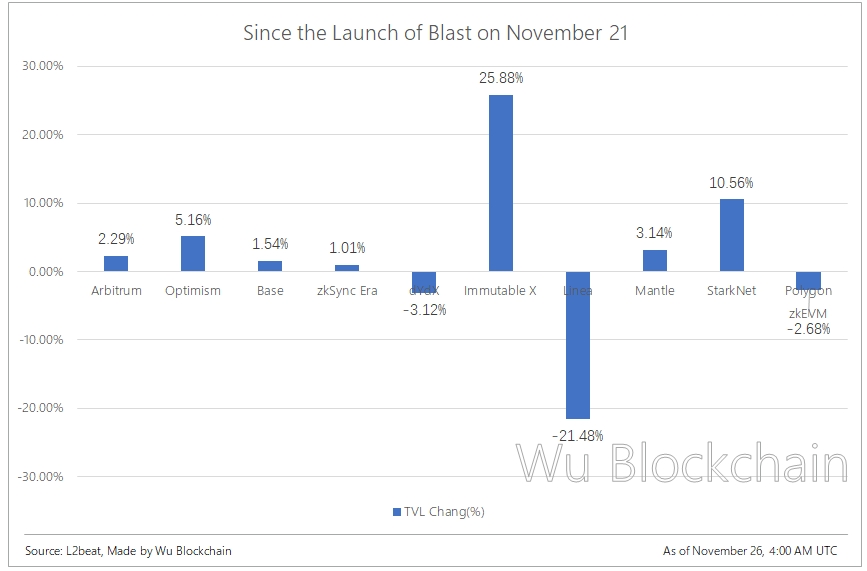A Brief Analysis of Blur Founder’s “Yield” L2 Blast: Where Does the Yield Come From? What Are the Concerns?
Author: defioasis, Wu Says Blockchain
On November 21, while announcing the end of Blur S2 and the start of S3, Blur founder Pacman launched L2 Blast, which is based on OP Rollup and comes with native yield rates for ETH and stablecoins, as well as the BLUR staking system. Blast raised $20 million in funding from investors such as Paradigm and Standard Crypto. With an invitation mechanism and a points system representing airdrop rewards, as of November 26, in less than six days, Blast has accumulated over $520 million in deposits, including over 220,000 ETH held in Lido and over $64 million DAI in Maker DSR. Compared to other L2s, Blast has surpassed zkSync Era, becoming the fourth largest public chain.
However, strictly speaking, Blast cannot yet be classified as an L2; it should be viewed as an intermediary contract for custody and locking, which can only accept deposits before the mainnet goes live. Its basic working principle is to receive users' ETH or stablecoins, stake ETH in Lido, and convert stablecoins into DAI to stake in Maker.
Questions and Responses
The market's doubts mainly consist of two aspects: contract security issues and a simplistic model.
Regarding security concerns, L2Beat pointed out that although the Blast contract (0x5f…a47d) is referred to as LaunchBridge, it is not actually a Rollup Bridge but a simple custody contract protected by a 3/5 multi-signature address. Blast also lacks the validity proofs required for L2 state roots or a necessary anti-fraud mechanism. Jarrod Watts, a developer relations engineer at Polygon, further noted that all five signers of the Blast multi-signature contract are new addresses with unknown identities; Blast is not an L2, lacks a testnet, transactions, bridges, rollbacks, and does not send transaction data to Ethereum; and the contract allows for any "mainnetBridge" contract to spend its maximum possible amounts of Lido and DAI. Yu Xuan, founder of Slow Mist, pointed out potential risks, including that Blast is an upgradeable contract, with a 3/5 multi-signature owner and no time lock; if it were to exit, it could either upgrade to a malicious logic contract or enable a malicious mainnetBridge.
In response to security concerns, Blast officials stated that time locks would reduce the security of smart contracts; in complex contracts, the security of immutable contracts may not be as good as that of upgradeable contracts. Each signature key in a multi-signature setup is independently secure, and each key should be stored in a cold wallet managed by independent parties and geographically separated. One of the multi-signature addresses will be updated within a week to switch the underlying hardware wallet provider; they will ensure that a single type of hardware wallet will not be used 3 out of 5 times, maintaining security even in unprecedented hardware wallet compromise situations.
As for Blast's simplistic model, it can be divided into two aspects: one is the technical simplicity, where a so-called L2 with nothing relies solely on a simple intermediary custody contract to absorb hundreds of millions of dollars in locked assets, surpassing the advantages accumulated by other prominent public chains over several months or even more than a year in just a few days; the second is operational simplicity, where the already criticized invitation mechanism and points system of Paradigm's two major projects, Blur and friend tech, are replicated, combined with mandatory locking before the mainnet launch and a leaderboard closely related to airdrops, capturing users' psychology of chasing airdrops and long-term rewards that are not visible, leading players to FOMO each other.
Although this simplistic model is indeed "ugly," it is actually reasonable. With backing from well-known institutions, successful projects as precedents, real sources of income, and calculable APY, depositing ETH/stablecoins in Blast essentially equates to a form of DeFi locked mining, with Lido or Maker providing basic yield rates, and the future Blast airdrop that can be exchanged for points representing mining rewards.
Impact on Other L2s
While some opinions suggest that the emergence of Blast will impact other L2s or force them to clarify their airdrop incentives, the fact that Blast achieved over $500 million in TVL in a short time is not primarily due to siphoning off other L2s.

As of November 21, 0:00 UTC, all four leading L2 public chains in terms of TVL have shown growth. The largest drop, Linea, has little relation to Blast; Linea's TVL surged from $86.5 million on November 15 to a historical peak of $263 million on the 23rd, mainly due to liquidity integration from cross-chain bridges Orbiter and Rhino. Arkham data shows that addresses suspected to be Orbiter (0x3F…6372 & 0xA7…73cE) and Rhino (0xC4…5eCB) net injected nearly 50,000 ETH into Linea in the past week (before the 23rd); the subsequent drop in TVL is also related to the withdrawal of liquidity from both Orbiter and Rhino, possibly for some liquidity testing related to Linea's cross-chain.

Removing the extremes, the chart becomes clearer. The TVL of mature leading L2s like Arbitrum and Optimism, which have already issued tokens, as well as the highly anticipated Base, zkSync Era, Mantle, and StarkNet, are all showing positive growth. The impact of Blast's emergence on other L2s may be much smaller than what the market voices suggest.
Given that the core data of mainstream L2s has not been significantly affected, the likelihood of them releasing accurate airdrops or providing more substantial incentives is low; most will likely maintain the status quo and continue existing operational strategies. In fact, I believe that compared to other L2s, such as Odyssey, where the correlation with airdrops is unclear, Blast's point system-based airdrop strategy is merely a variation of an airdrop customer acquisition strategy rather than a direct competition of underlying technology and ecological applications. Therefore, it can also be seen that the fundamentals of most other L2 public chains remain stable and will not be significantly affected by the emergence of a new entity.
The funds absorbed by Blast should mainly come from idle funds, primarily due to the decline in DeFi yields, especially as there are few stable mining pools suitable for large funds. Blast provides a DeFi mining pool with "Lido/Maker's basic yield rate + points redeemable for airdrop mining rewards," which has strong appeal for those pursuing stable returns with controllable risks.
Impact on Blur
At the same time as Blast's launch, Pacman also introduced a staking mechanism for BLUR, allowing users to earn points representing airdrops, with the S3 airdrop to be shared between NFT traders and BLUR stakers. As of November 26, 336 million BLUR has been staked, worth over $200 million, exceeding 10% of the total supply.
Although there is currently no clear connection between Blast and Blur, Blast should be seen as part of Pacman's expansion of the Blur NFT trading market, similar to the lending platform Blend. According to official data, during S2, Blur achieved a trading volume of $6.1 billion, with over 260,000 users, averaging a 65% market share, firmly surpassing OpenSea to become the absolute leader in the Ethereum NFT trading market. As the spot market stabilizes, Blur's lending market, Blend, has also quickly captured a major share of the NFT lending sector, forming a Matthew effect where the strong get stronger. Blur and Blend have already secured major market shares in their respective lanes and have achieved self-sustainability while generating stable income, which will serve as a solid foundation for future expansion. Therefore, the pessimistic view that Pacman is abandoning Blur to start anew is unfounded.

(Data source: https://x.com/blur_io/status/1726755862423990409?s=20)
Referring to CEX token trading, futures trading volume is often several times that of spot trading and is one of the core sources of income, so NFT futures are also worth exploring. Unlike CEX, which firmly occupies the futures trading volume of FT, the resistance for on-chain NFT futures is significantly lower, but it still needs to overcome the high gas fees on Ethereum.
Pacman believes that the two biggest opportunities for NFTs are reducing transaction costs and institutional-level NFT Perps, which is why L2 is needed; the Blur Bid Pool holds tens of thousands of ETH but cannot enjoy the yields. Launching L2 can also address this issue, giving rise to Blast, which has underlying staking yields. In the future, ETH in the Blur Bid Pool is likely to be deposited in Blast, then returned as blurETH for trading, allowing for transactions while enjoying native ETH staking yields, and it may even establish its own native staking protocol instead of relying on Lido. Additionally, significantly lowering transaction costs may stimulate more spot trading volume.
If the blurETH built in the Bid Pool on Blast can also serve directly as trading pair assets for NFT Perps or add some composability similar to GLP, it could unleash even greater liquidity.
As an L2, Blast will inevitably open up to more protocols and developers in the future, and it is not impossible for Paradigm to create a super application similar to friend tech on Blast. To capture users and give back to the community, these new applications may consider airdropping to Blast and users closely related to it.










